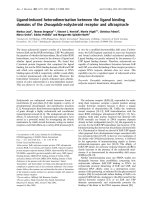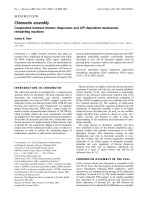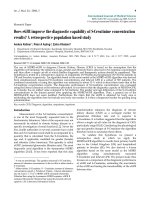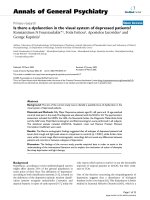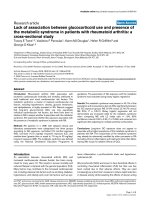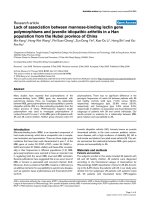Báo cáo y học: "Is closer linkage between systemic lupus erythematosus and anti-double-stranded DNA antibodies a desirable and attainable goal" ppsx
Bạn đang xem bản rút gọn của tài liệu. Xem và tải ngay bản đầy đủ của tài liệu tại đây (43.37 KB, 3 trang )
85
ACR = American College of Rheumatology; ANA = antinuclear antibodies; dsDNA = double-stranded DNA; ELISA = enzyme-linked immunosor-
bent assay; SLE = systemic lupus erythematosus; Sm = Smith.
Available online />Abstract
The anti-double-stranded DNA (anti-dsDNA) antibody test incor-
porated in the 1982 revised American College of Rheumatology
criteria for the classification of systemic lupus erythematosus
needs updating to reflect current insights and technical achieve-
ments, including allowance for the presence of nonpathogenic anti-
dsDNA antibodies. As we need to develop at least some measure
of pathogenicity of anti-dsDNA antibodies, we propose that initial
anti-dsDNA antibody screening is done by sensitive ELISA and
supplemented by more stringent assays. Simultaneously the
relevance of anti-dsDNA antibody presence needs to be restricted
to clinical manifestations, thought to be caused by anti-dsDNA
antibody and within an appropriate time frame.
Introduction
After descriptions of organ involvement in patients with
archetypal lupus erythematosus skin lesions, and
development of the concept of systemic lupus
erythematosus (SLE) as a collagen vascular disease [1,2],
a collaborative effort in the USA developed preliminary
SLE classification criteria for interseries and epidemiologic
evaluation. Retrospectively, the cumulative presence of
four or more criteria over a 7-year period correctly
classified patients with 88% sensitivity and 95%
specificity [3]. In 1982 the earlier autoimmune features
(lupus erythematosus cells or false positive test for
syphilis) were expanded with fluorescent antinuclear
antibodies and serum antibodies against DNA and/or
Smith (Sm) antigen in a revised set of criteria [4]. This
revision, again based on retrospective statistical
associations, has had a huge impact on practical and
theoretical considerations of SLE. Although reappraisal of
the whole criteria set for SLE is currently being discussed
[5], we focus here on the flawed relationship between
serum anti-double-stranded DNA (anti-dsDNA) antibodies
and SLE. Both B cell and T cell autoimmunity to dsDNA
and/or nucleosomes are not confined to SLE, as shown by
the specificity of anti-dsDNA antibody-inducing T cells for
autologous (that is, non-infectious self) or infectious non-
self DNA-binding proteins [6,7] as well as the finding that
the potential of DNA-specific B cells to expand clonally
and affinity mature towards dsDNA is an inherent property
of the immune system of non-diseased individuals [8]. The
initiation of IgG anti-DNA antibody production is not itself
unique to SLE, as shown by findings especially in single-
gene-aberration infections and also drug treatments
(which generally induce only transient antibodies of the
IgM isotype with tumor necrosis factor-α-blocking agents
as the most recent example), as discussed recently [9]. To
obtain a closer link between SLE pathophysiology and
autoimmunity to DNA and/or nucleosomes, we need to
make allowances for pathophysiologically irrelevant anti-
dsDNA antibodies in our current empirical approach to
anti-dsDNA testing.
The 1982 revised American College of
Rheumatology (ACR) classification criteria
and anti-dsDNA antibody detection
After a cluster analysis of 30 disease variables in 177
patients from 18 US clinics, 96% of SLE patients fulfilled –
over time – at least four criteria, compared with 4% of 166
patients with predominantly chronic polyarthritis [4]. This
ability to discriminate retrospectively between SLE and
polyarthritis patients has evolved into the understanding
that the criteria are useful for diagnosing SLE in general,
although this has never been substantiated. Half of the
patients in the ACR cohort did not fulfill the criteria at
clinical diagnosis and would nowadays be classified (and
probably treated) as undifferentiated/lupus-like autoimmune
disease. Anti-dsDNA antibodies were detected (by local
laboratories at undisclosed time points) in 113 of 166
Commentary
Is closer linkage between systemic lupus erythematosus and
anti-double-stranded DNA antibodies a desirable and attainable
goal?
Hans C Nossent
1,2
and Ole Petter Rekvig
2,3
1
Department of Rheumatology, Institute of Clinical Medicine, University of Tromsø, Norway
2
Department of Rheumatology, University Hospital North Norway, Tromsø, Norway
3
Department of Biochemistry, Institute of Medical Biology, University of Tromsø, Norway
Corresponding author: Hans C Nossent,
Published: 10 February 2005
Arthritis Res Ther 2005, 7:85-87 (DOI 10.1186/ar1707)
© 2005 BioMed Central Ltd
86
Arthritis Research & Therapy Vol 7 No 2 Nossent and Rekvig
(67%) SLE patients and 7 of 91 (8%) control patients,
also resulting in low positive (8) and negative (0.4)
likelihood ratios for SLE with anti-dsDNA antibody testing,
as confirmed by more recent data [10]. A basic flaw with
this criteria set is the ‘two for the price of one’ principle:
the presence of either anti-dsDNA or anti-Sm antibody
results in the fulfillment of two criteria, namely criteria 10
(anti-DNA/anti-Sm antibody) and 11 (a positive antinuclear
antibodies (ANA) test, caused by the anti-DNA/anti-Sm
antibody). When classifying patients in the clinic or in
studies, the presence of anti-dsDNA (or anti-Sm
antibodies) should therefore eliminate the use of ANA as a
criterion; this will require more clinical features to be
present for SLE classification, and this relatively simple
alteration might significantly alter the face of SLE as we
know it today.
The broad definition of ‘antibody to native DNA in an
abnormal titer’ [4] reflects technical standards more than
30 years old and has allowed an outgrowth of methods for
anti-dsDNA antibody detection. All current assays detect
anti-dsDNA antibodies with divergent properties in terms of
avidity, structural specificity and clinical associations [11].
If the anti-dsDNA antibody criterion in SLE classification is
to remain useful, its definition should represent current
trends and insights. Head-to-head comparisons of the
various assays in contemporary, unselected, multinational
cohorts of patients with new-onset disease are needed to
determine the specificity and sensitivity (which seem to be
inversely related) of various anti-dsDNA antibody assays for
SLE, while focusing on the organ specificity of anti-dsDNA
antibody-mediated injury.
Anti-dsDNA antibodies and lupus
pathophysiology
Anti-dsDNA antibodies and SLE pathophysiology are
currently quite loosely connected in both classification and
clinical practice. This hampers the study of the correlation
of anti-dsDNA antibodies and effects on organs in SLE,
because statistical associations cannot substitute for
specific anti-dsDNA antibody-mediated pathophysiological
processes. Because anti-dsDNA antibodies can be eluted
from diseased experimental and human lupus kidneys and
are present in patient sera during proliferative lupus
nephritis, they are likely to be involved in the development
of lupus nephritis [12,13]. Aside from the weak correlation
with skin disease activity in patients with discoid and
acute cutaneous lupus erythematosus [14], there is little
evidence that anti-dsDNA antibodies are pathophysio-
logically involved in other clinical manifestations. Recent
findings that intrathecal binding of anti-dsDNA antibodies
to the NR2 glutamate receptor induces apoptotic neuronal
death must be confirmed in patient cohorts [15].
Assuming that antibodies detected in serum truthfully
reflect the process in situ, we therefore need assays that
can measure pathogenicity, avidity or specificity for local
DNA structures or substructures. However, anti-dsDNA
antibodies might be present in sera for many years before
the development of experimental and human lupus
[16,17], and serum anti-dsDNA antibodies can also be
detected by various techniques for a prolonged period in
patients with quiescent established SLE [18]. If one
accepts that this autoimmunity nonetheless relates to
pathophysiological events, there is an obvious need to
determine when and why the switch from nonpathogenic
and clinically irrelevant to pathogenic and clinically
relevant antibodies occurs. If anti-DNA antibody
pathogenicity is determined by the interaction between
antibody and tissue-specific antigens, the selection
principle and/or the organ-specific binding properties
induced by local modifications of anti-DNA antibodies
must be determined [19,20].
At present, a timely relationship between the presence of
anti-dsDNA antibodies and clinical manifestations is not
required in SLE classification and diagnosis. For example,
the previous presence of anti-dsDNA antibodies (by any
assay) and accordingly a positive ANA test will qualify a
patient with a UV-sensitive rash for SLE classification and
diagnosis, whereas clinical manifestations do not coincide
with anti-dsDNA antibody detection. Monthly increases in
anti-dsDNA antibody levels (Farr assay) to guide
preventive therapy in European lupus patients significantly
reduced the number of relapses as well as the number of
patients requiring cytotoxic agents [21]. Thus, restricting
the time span for relevant (in the context of their potential
to induce pathology) anti-dsDNA antibodies to a defined
time period (such as 4 to 6 weeks, as suggested on the
basis of clinical evidence [22]) before the occurrence of
renal and skin lesions in the study and follow-up of SLE
patients will provide a stronger framework for the study of
the role of anti-dsDNA antibodies in SLE.
Anti-dsDNA antibodies assays
We currently lack a clear strategy for evaluating the
development of pathogenic anti-dsDNA antibodies.
Although we recognize the limits of our knowledge on the
structural specificities and avidities, affinity maturation and
clinical associations of anti-dsDNA antibodies, the following
provisional two-step strategy for both diagnosis and follow-
up seems reasonable. Screening with the sensitive ELISA
assay detects most anti-dsDNA antibodies irrespective of
pathogenic impact [23], and following-up positive ELISA
results by more stringent assays (Crithidia luciliae
immunofluorescence, Farr assay with circular dsDNA as
antigen, EliA anti-dsDNA assays or solution-phase ELISA)
will determine the presence of potentially more pathogenic
anti-dsDNA antibodies [11,24]. Limitations notwithstanding,
this test strategy might especially aid clinicians to determine
whether SLE patients suffer from cool (‘benign’) lupus, with
mainly nonpathogenic anti-dsDNA antibodies present, or
hot (‘malignant’) lupus, in which high-avidity anti-dsDNA
87
antibodies may mediate end-organ dysfunction. This
strategy follows practical developments in which economic
considerations have forced the replacement of other anti-
dsDNA assays with ELISA testing. Unlike the consensus-
based 1997 update of ACR criteria for SLE classification
[25], officially redefining the methodology and clinical
relevance of anti-dsDNA antibody profiles in SLE
classification and diagnosis will require formal testing in
unselected cohorts. Such a practically and intellectually
challenging undertaking should provide an answer to the
contemporary dilemma of whether the presence of anti-
dsDNA antibodies in any given assay should be considered
relevant only when concomitant with nephritis or dermatitis.
Conclusions
The anti-dsDNA antibody test incorporated in the 1982
revised ACR criteria for SLE classification needs
updating. ELISA screening (for lower avidity anti-dsDNA
antibodies) followed by risk stratification through the use
of more stringent assays (Farr, EliA, Crithidia) and
restricting the relevance of anti-dsDNA antibody presence
to specific clinical manifestations might provide us with a
better index of the pathogenicity of anti-dsDNA antibodies.
Furthermore, in the presence of anti-dsDNA antibodies
ANA should no longer be considered a valid classification
criterion. This strategy might ultimately facilitate the
differentiation between SLE patients with benign disease
variants and those with the classical syndrome of severe
skin and renal disease in the presence of pathogenic anti-
dsDNA autoantibodies.
Competing interests
Both HCN and OPR have received speaker/travel fees
from Pharmacia Norway AS, which produces an ELISA
assay for the detection of anti-dsDNA Ab.
References
1. Kaposi M: Neue Beitrage zur Kenntnis des Lupus Erythemato-
sus. Arch Dermatol Syphil 1872, 4:36-78.
2. Klemperer P, Pollack AD, Baehr G: The pathology of dissemi-
nated lupus erythematosus. Arch Pathol 1941, 32:569-631.
3. Cohen AS, Reynolds WE, Franklin EC, Knlka JP, Ropes MW,
Shulman LE, Wallace SL: Preliminary criteria for the classifica-
tion of systemic lupus erythematosus. Bull Rheum Dis 1971,
21:643-648.
4. Tan EM, Cohen AS, Fries JF, Masi AT, McShane DJ, Rothfield NF,
Schaller JG, Talal N, Winchester RJ: The 1982 revised criteria
for the classification of systemic lupus erythematosus. Arthri-
tis Rheum 1982, 25:1271-1277.
5. Petri M, Magder L: Classification criteria for systemic lupus
erythematosus: a review. Lupus 2004, 13:829-837.
6. Rekvig OP, Andreassen K, Moens U: Antibodies to DNA –
towards an understanding of their origin and pathophysiologi-
cal impact in systemic lupus erythematosus. Scand J Rheuma-
tol 1998, 27:1-6.
7. Kaliyaperumal A, Mohan C, Wu W, Datta SK: Nucleosomal
peptide epitopes for nephritis-inducing T helper cells of
murine lupus. J Exp Med 1996, 183:2459-2469.
8. Chen C, Nagy Z, Radic MZ, Hardy RR, Huszar D, Camper SA,
Weigert M: The site and stage of anti-DNA B-cell deletion.
Nature 1995, 373:252-255.
9. Rekvig OP, Nossent JC: Anti-double-stranded DNA antibodies,
nucleosomes, and systemic lupus erythematosus: a time for
new paradigms? Arthritis Rheum 2003, 48:300-312.
10. Kavanaugh A: The utility of immunologic laboratory tests in
patients with rheumatic diseases. Arthritis Rheum 2001, 44:
2221-2223.
11. Haugbro K, Nossent JC, Winkler T, Figenschau Y, Rekvig OP:
Anti-dsDNA antibodies and disease classification in antinu-
clear antibody positive patients: the role of analytical diversity.
Ann Rheum Dis 2004. 63:386-394.
12. Winfield JB, Faiferman I, Koffler D: Avidity of anti-DNA antibod-
ies in serum and IgG glomerular eluates from patients with
systemic lupus erythematosus. Association of high avidity
antinative DNA antibody with glomerulonephritis. J Clin Invest
1977, 59:90-96.
13. Nossent HC, Henzen-Logmans SC, Vroom TM, Berden JH,
Swaak TJ: Contribution of renal biopsy data in predicting
outcome in lupus nephritis. Analysis of 116 patients. Arthritis
Rheum 1990, 33:970-977.
14. Crowson AN, Magro C: The cutaneous pathology of lupus ery-
thematosus: a review. J Cutan Pathol 2001, 28:1-23.
15. DeGiorgio LA, Konstantinov KN, Lee SC, Hardin JA, Volpe BT,
Diamond B: A subset of lupus anti-DNA antibodies cross-
reacts with the NR2 glutamate receptor in systemic lupus ery-
thematosus. Nat Med 2001, 7:1189-1193.
16. Hahn BH: Antibodies to DNA. N Engl J Med 1998, 338:1359-
1368.
17. Arbuckle MR, McClain MT, Rubertone MV, Scofield RH, Dennis
GJ, James JA, Harley JB: Development of autoantibodies
before the clinical onset of systemic lupus erythematosus. N
Engl J Med 2003, 349:1526-1533.
18. Isenberg DA, Ravirajan CT, Rahman A, Kalsi J: The role of anti-
bodies to DNA in systemic lupus erythematosus – a review
and introduction to an international workshop on DNA anti-
bodies held in London, May 1996. Lupus 1997, 6:290-304.
19. Li J, Fernandez L, O’Connor KC, Imanishi-Kari T, Stollar BD: The
rearranged V(H) domain of a physiologically selected anti-
single-stranded DNA antibody as a precursor for formation of
IgM and IgG antibodies to diverse antigens. J Immunol 2001,
167:3746-3755.
20. Jang YJ, Stollar BD: Anti-DNA antibodies: aspects of structure
and pathogenicity. Cell Mol Life Sci 2003, 60:309-320.
21. Bootsma H, Spronk P, Derksen R, de Boer G, Wolters-Dicke H,
Hermans J, Limburg P, Gmelig-Meyling F, Kater L, Kallenberg C:
Prevention of relapses in systemic lupus erythematosus.
Lancet 1995, 345:1595-1599.
22. Swaak AJ, Smeenk RJ: Following the disease course in sys-
temic lupus erythematosus: are serologic variables of any
use? J Rheumatol 1996, 23:1842-1844.
23. Fritzler MJ, Wiik A, Tan EM, Smolen JS, McDougal JS, Chan EK,
Gordon TP, Hardin JA, Kalden JR, Lahita RG, et al.: A critical
evaluation of enzyme immunoassay kits for detection of anti-
nuclear autoantibodies of defined specificities. III. Compara-
tive performance characteristics of academic and
manufacturers’ laboratories. J Rheumatol 2003, 30:2374-2381.
24. Derksen RH, Bast EJ, Strooisma T, Jacobs JW: A comparison
between the Farr radioimmunoassay and a new automated
fluorescence immunoassay for the detection of antibodies
against double stranded DNA in serum. Ann Rheum Dis 2002,
61:1099-1102.
25. Hochberg MC: Updating the American College of Rheumatol-
ogy revised criteria for the classification of systemic lupus
erythematosus. Arthritis Rheum 1997, 40:1725.
Available online />
